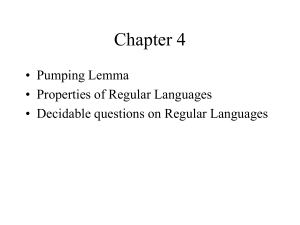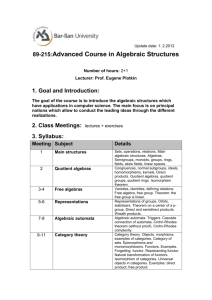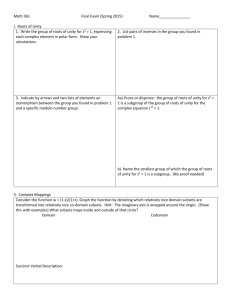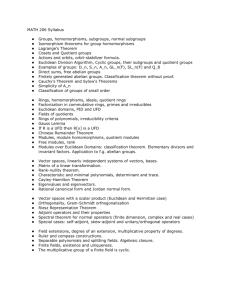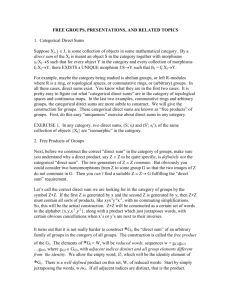MTHSC 412 Section 6.2 – Quotient Rings and Homomorphisms
advertisement
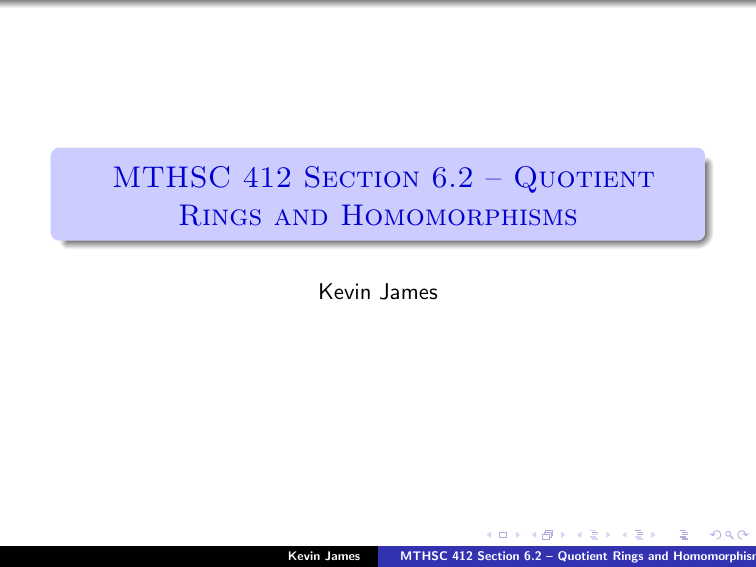
MTHSC 412 Section 6.2 – Quotient
Rings and Homomorphisms
Kevin James
Kevin James
MTHSC 412 Section 6.2 – Quotient Rings and Homomorphism
Theorem
Let I E R. If a + I = b + I and c + I = d + I , then
(a + c) + I = (b + d) + I
Kevin James
and
ac + I = bd + I .
MTHSC 412 Section 6.2 – Quotient Rings and Homomorphism
Theorem
Let I E R. If a + I = b + I and c + I = d + I , then
(a + c) + I = (b + d) + I
and
ac + I = bd + I .
Definition
Suppose that I E R. Then we define addition and multiplication on
R/I by
(a + I ) + (b + I ) = (a + b) + I
Kevin James
and
(a + I )(b + I ) = ab + I .
MTHSC 412 Section 6.2 – Quotient Rings and Homomorphism
Example
Suppose that R = Z[x] and that I = (x 2 , 2). What are the distinct
cosets for R/I ? Write out addition and multiplication tables for
R/I .
Kevin James
MTHSC 412 Section 6.2 – Quotient Rings and Homomorphism
Example
Suppose that R = Z[x] and that I = (x 2 , 2). What are the distinct
cosets for R/I ? Write out addition and multiplication tables for
R/I .
Theorem
Suppose that I E R. Then,
1
R/I is a ring.
2
If R is commutative then R/I is commutative.
3
If R has an identity, then R/I has identity 1R + I .
Kevin James
MTHSC 412 Section 6.2 – Quotient Rings and Homomorphism
Definition
R/I is called the quotient ring or factor ring of R by I .
Kevin James
MTHSC 412 Section 6.2 – Quotient Rings and Homomorphism
Homomorphisms
Definition
Suppose that f : R → S is a homomorphism of rings. We define
the kernel of f as
ker(f ) = {r ∈ R : f (r ) = 0S }.
Kevin James
MTHSC 412 Section 6.2 – Quotient Rings and Homomorphism
Homomorphisms
Definition
Suppose that f : R → S is a homomorphism of rings. We define
the kernel of f as
ker(f ) = {r ∈ R : f (r ) = 0S }.
Theorem
Suppose that f : R → S is a homomorphism of rings. Then
ker(f ) E R.
Kevin James
MTHSC 412 Section 6.2 – Quotient Rings and Homomorphism
Homomorphisms
Definition
Suppose that f : R → S is a homomorphism of rings. We define
the kernel of f as
ker(f ) = {r ∈ R : f (r ) = 0S }.
Theorem
Suppose that f : R → S is a homomorphism of rings. Then
ker(f ) E R.
Theorem
Suppose that f : R → S is a homomorphism of rings. Then
ker(f ) = {0} if and only if f is injective.
Kevin James
MTHSC 412 Section 6.2 – Quotient Rings and Homomorphism
Theorem
Suppose that I E R. Then the map π : R → R/I given by
π(r ) = r + I is a surjective ring homomorphism with kernel I .
Kevin James
MTHSC 412 Section 6.2 – Quotient Rings and Homomorphism
Theorem
Suppose that I E R. Then the map π : R → R/I given by
π(r ) = r + I is a surjective ring homomorphism with kernel I .
Definition
The map π is called the natural homomorphism from R to R/I .
Kevin James
MTHSC 412 Section 6.2 – Quotient Rings and Homomorphism
Theorem
Suppose that I E R. Then the map π : R → R/I given by
π(r ) = r + I is a surjective ring homomorphism with kernel I .
Definition
The map π is called the natural homomorphism from R to R/I .
Definition
Suppose that f : R → S is a homomorphism of rings. Then we say
that S is a homomorphic image of R.
Kevin James
MTHSC 412 Section 6.2 – Quotient Rings and Homomorphism
Theorem
Suppose that I E R. Then the map π : R → R/I given by
π(r ) = r + I is a surjective ring homomorphism with kernel I .
Definition
The map π is called the natural homomorphism from R to R/I .
Definition
Suppose that f : R → S is a homomorphism of rings. Then we say
that S is a homomorphic image of R.
If f is an isomorphism then we say that S is an isomorphic image
of R.
Kevin James
MTHSC 412 Section 6.2 – Quotient Rings and Homomorphism
Theorem (First Isomorphism Theorem)
Suppose that f : R → S is a surjective homomorphism of rings
with kernel K . Then R/K ∼
= S.
Kevin James
MTHSC 412 Section 6.2 – Quotient Rings and Homomorphism
Theorem (First Isomorphism Theorem)
Suppose that f : R → S is a surjective homomorphism of rings
with kernel K . Then R/K ∼
= S.
Example
Consider the ring R = {f : R → R | f is continuous}. Let
I = {f ∈ R | f (2) = 0 = f (3)}. Describe R/I .
Kevin James
MTHSC 412 Section 6.2 – Quotient Rings and Homomorphism
Theorem (First Isomorphism Theorem)
Suppose that f : R → S is a surjective homomorphism of rings
with kernel K . Then R/K ∼
= S.
Example
Consider the ring R = {f : R → R | f is continuous}. Let
I = {f ∈ R | f (2) = 0 = f (3)}. Describe R/I .
Example
Describe all homomorphic images of Z.
Kevin James
MTHSC 412 Section 6.2 – Quotient Rings and Homomorphism



